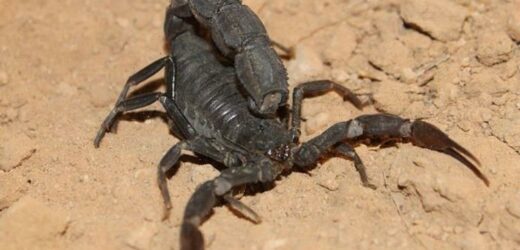Brian Cox discovers the Mojave Desert Sand Scorpion
We use your sign-up to provide content in ways you’ve consented to and to improve our understanding of you. This may include adverts from us and 3rd parties based on our understanding. You can unsubscribe at any time. More info
The venomous arachnids were flushed out of their lairs and into peoples’ homes after a storm tore through the region. According to local media, 503 people in the southern Egyptian province have been treated for scorpion stings. At least three people were originally reported to have died from the stings, however, these claims have been denied by Egypt’s acting Health Minister and Aswan Governor Ashraf Attia.
Reports of the “scorpionado” came after several days of hail, rainfall and flooding battered the region.
Situated on the banks of the River Nile, Aswan is one of the world’s driest cities.
The city’s population of more than 1.5 million people typically sees about 0.12 inches (three millimetres) of rain a year.
The intense thunderstorms and deluge have plunged the city and surrounding areas into chaos over the weekend, causing power outages and closing schools.


The storms also appear to have flushed scorpions out of their desert homes and onto the streets, where they attacked hundreds of people.
According to Egypt’s health ministry, 503 people have been treated with anti-venom and everyone has survived.
Dr Khaled Abdel Ghaffar, the Minister of Higher Education and Scientific Research, wrote in a Facebook post on Saturday that more than 3,000 doses of the anti-venom have been distributed across the region in case of future attacks.
Ehab Hanafy, the undersecretary of the Health Ministry in Aswan, has said the three reported deaths were “due to storm-related accidents” and not scorpion stings.
Terrifying video clips and pictures shared on social media show fierce winds and lighting battering the city.
Egyptologist discusses ‘surprise’ hieroglyphic discovery
The storms were tracked from space by the US National Oceanic and Atmospheric Administration (NOAA).
The weather agency tweeted: “On November 12, Europe’s #Meteosat11 watched severe thunderstorms erupt over southeastern Egypt.
“The storm’s heavy rains, hail, and flooding not only damaged property around the city of Aswan, but forces swarms of scorpions from the burrows, which stung hundreds of people.”
Egypt’s Aswan province is home to the Androctonus crassicauda scorpion species, though many more exist throughout the country.
The Androctonus or “Arabian fat-tailed scorpion” is among the deadliest species and is typically found across North Africa and the Middle East.


The scorpion is known to cause several human deaths each year.
A 2019 report in the journal Toxicology Reports warned: “Cardiac dysrhythmia is main cause of death in scorpion envenomation cases.
“Leiurus quinquestriatusis scorpion species are more toxic than Androctonus crassicauda, while late presentation of manifestation in Androctonus crassicauda sting cases responsible for bad prognosis and high mortality among such cases.”
The world’s most venomous scorpion is the Arizona bark scorpion.
Its venom can cause severe pain and nausea lasting between 24 and 72 hours.
After news of the scorpion plague in Egypt broke, many have attributed it to the effects of climate change.
Eliot Jacobson, a retired professor of mathematics, tweeted: “Scorpionadoes is now the 75th entry in my list of consequences of climate change.”
And meteorologist Kelly Snowbeck said: “Strong storms in Egypt led to a swarm of scorpions.
“Yes, this nightmare actually happened.”
Source: Read Full Article


